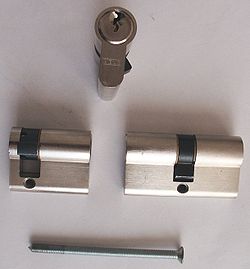
Cylinder lock
Encyclopedia

Lock (device)
A lock is a mechanical or electronic fastening device that is released by a physical object or secret information , or combination of more than one of these....
constructed with a cylinder
Cylinder (geometry)
A cylinder is one of the most basic curvilinear geometric shapes, the surface formed by the points at a fixed distance from a given line segment, the axis of the cylinder. The solid enclosed by this surface and by two planes perpendicular to the axis is also called a cylinder...
that a locksmith can easily unscrew to facilitate rekeying. The cylinder may contain any of a variety of locking mechanisms, including the pin tumbler lock
Pin tumbler lock
The pin tumbler lock is a lock mechanism that uses pins of varying lengths to prevent the lock from opening without the correct key...
, the wafer tumbler lock
Wafer tumbler lock
A wafer tumbler lock is a type of lock that uses a set of flat wafers to prevent the lock from opening unless the correct key is inserted. This type of lock is similar to the pin tumbler lock and works on a similar principle. However, unlike the pin tumbler lock, the wafer is a single piece...
and the disc tumbler lock
Disc tumbler lock
A disc tumbler lock or Abloy Disklock is a lock composed of slotted rotating detainer discs. A specially cut key rotates these discs like the tumblers of a safe to align the slots, allowing the sidebar to drop into the slots, thus opening the lock. Unlike a wafer tumbler lock or a pin tumbler...
.
The first main advantage to a cylinder lock, also known as a profile cylinder lock, is that the cylinder may be changed without altering the boltwork hardware. Removing the cylinder typically requires only loosening a set screw, then unscrewing the cylinder from the boltwork. The second is that it is usually possible to obtain, from various lock manufacturers, cylinders in different formats that can all be used with the same type of key. This allows the user to have keyed-alike, and master-keyed systems that incorporate a wide variety of different types of lock, such as nightlatches, deadbolts and roller door locks. Typically, padlock
Padlock
Padlocks are portable locks used to protect against theft, vandalism, sabotage, unauthorized use, and harm. They are designed to protect against some degree of forced and surreptitious entry.- History :...
s can also be included, although these rarely have removable cylinders.
Standardised types of cylinder include key-in-knobset cylinders, rim (also known as nightlatch) cylinders, Ingersoll format cylinders, American, and Scandinavian round mortise cylinders, and Scandinavian oval cylinders. There are also standardised cross-sectional profiles for lock cylinders that may vary in length - for example to suit different door thicknesses. These profiles include the europrofile (or DIN standard), the British oval profile and the Swiss profile.
Cruciform pin-tumbler locks may also use interchangeable cylinders, as do a few sophisticated lever locks.
Individually keyed system (KD)
With an individually keyed system, each cylinder can be opened by its unique key.
Keyed alike (KA)
This system allows for a number of cylinders to be operated by the same key. It is ideally suited to residential and commercial applications such as front and back doors.
Master keyed (MK)
A master-keyed system involves each lock having its own individual key which will not operate any other lock in the system, but where all locks can be operated by a single master-key. This is usually applied in commercial environments.
Grand master keyed (GMK)
This is an extension of the master-keyed system where each lock has its own individual key and the locks are divided into 2 or more groups. Each lock group is operated by a master-key and the entire system is operated by one grand master-key. This is ideally utilized in complex commercial systems.
Common entrance suite / Maison keying (CES)
This system is widely used in apartments, office blocks and hotels. Each apartment (for example) has its own individual key which will not open the doors to any other apartments, but will open common entrance doors and communal service areas. It is often combined with a Master Keyed system in which said key is kept by the landlord.
External links
- http://www.casac.org.uk/burglary-reduction/home-security-advice/euro-profile-locksWhat's the problem with Euro Profile Cylinder door locks?}

